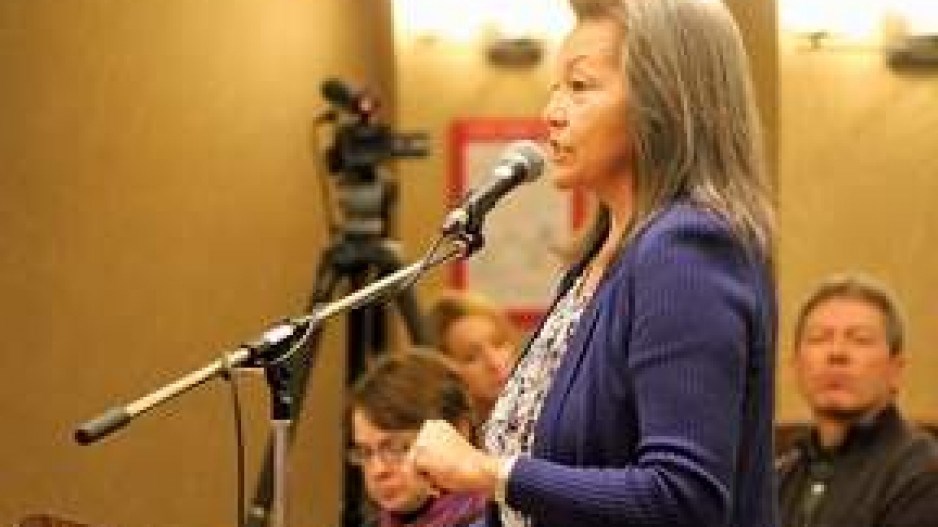First Nations say they have found themselves in a David and Goliath battle when it comes to participating in and evaluating a BC Hydro plan to build the Site C dam.
BC Hydro’s level of consultation on the $7.9 billion proposal came under fire during the second day of public hearings on the proposal in Fort St. John on Tuesday, after a representative for the Treaty 8 Tribal Association argued that the crown corporation ignored First Nations when researching alternatives to building Site C to meet future energy needs.
It prompted an interjection from Joint Review Panel member Jocelyne Beaudet, who questioned the definition of consultation among the presenters.
“I think the communications staff at BC Hydro has a vast communications strategy and action plan to try to consult everyone,” said Beaudet. “We're starting to hear people are not satisfied with that. I'd like to know, then, what is the definition, of everyone ... (of) consultation?”
While Site C has been in Hydro’s plans for decades, concerns remain that Hydro went into its latest push to build the dam without first approaching impacted communities to discuss how the Peace River could be harnessed for energy, and what alternatives to Site C might look like.
“A consultation process with a determined outcome is not consultation – that’s an informative session,” West Moberly Chief Roland Willson responded to the panel.
Treaty 8 Tribal Chief Liz Logan told Beaudet she would have to consult with her five member chiefs before putting forth an official written statement to the panel.
However, she did say, “consultation is not coming to our office with the volumes of info they have and say, ‘Here, have a look at this and let us know what you think,’ and then leave.”
Logan said First Nations groups are in “a David and Goliath situation” when it comes to poring through massive technical reports prepared by BC Hydro experts.
“We need to be informed fully and meaningfully, and we need to have the capacity and the expertise to help us make our decisions, and we don’t have that,” said Logan.
“We have a team of maybe three people compared to what? I think you’ve seen about 40 of BC Hydro’s people here today. That’s not consultation. Where’s the fairness in that?”
Hydro has said it held some 120 consultation meetings with local governments, stakeholders, property owners and the general public since 2007. It expects to continue consultations through construction and operations, if Site C is approved, spokesperson Dave Conway said.
Hydro has also held more than 430 meetings with 28 of the 29 aboriginal groups it was directed to consult with by the regulators, Conway noted.
“All BC Hydro projects consult with affected stakeholders, and we have a duty to consult and accommodate First Nations,” Conway said. “While the principles of our consultation programs are going to be similar across projects, each project differs in size, scope, proximity to communities and First Nations and a number of other factors.
“Site C is BC Hydro’s largest proposed project, so the consultation program would certainly be among the most comprehensive for us,” he said.
Conway added BC Hydro has doled out more than $12.5 million in capacity funding to aboriginal groups to carry out their own land use and community studies to participate in the environmental assessment process, including public hearings.
Conway said Hydro will respond to issues raised on Tuesday later in the hearings.
If Site C is approved, Hydro would build a 60-metre-high earth dam about seven kilometres from downtown Fort St. John, along with a 1,100-megawatt generating station. The dam’s reservoir would extend 83 kilometres upstream to the Peace Canyon Dam, flooding thousands of hectares of farmland, along with heritage sites and land used by area First Nations under treaty rights.
The matter has proven especially sensitive for Arlene Boon, a third-generation landowner and farmer along the Peace River, who fought back tears describing the possibility of being flooded out that has hung over her family’s head since 1957.
“Having BC Hydro come to you with a document asking, ‘Do you want the highway to go through your home, or do you want the highway to go through your agricultural land?’ – to me, that’s not consultation,” she said. “That’s insulting.”
Rick Hendriks, representing Treaty 8, noted there are differing views when it comes to defining consultation. However, he said First Nations need to be brought to the table as partners to appropriately reconcile competing interests. He pointed to Wuskwatim, a dam recently built in northern Manitoba.
"”The proponent initially wanted to build a much bigger facility, but the First Nations said, ‘’'s too much flooding for us. We already have too much flooding,’” he said. “The similarities here, there are many. At the end, they ended up with a facility that is much smaller, and I'm sure it was less economic, but there was no flooding.
“The proponent got something that was in their interests, and the Nations got something that was in their interests.”




